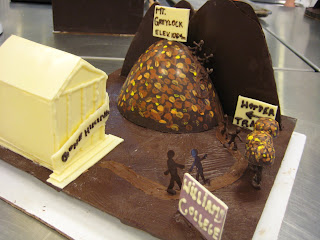
My name is Liz, and I have a cookbook problem. This "problem" began about a year ago and grew rapidly, eventually demanding its own bookshelf in my kitchen, where real estate is at a premium. While many cookbooks have a few standout recipes, occasionally a cookbook seems to be entirely composed of winning recipes. The cookbook from the folks behind Red Hook bakery Baked is one of the latter.
The brownies are solid gold fudgy deliciousness, the hazelnut cinnamon chip biscotti are just a notch below crack and Diet Coke on the addictiveness scale, and the chocolate flourless cake could satisfy even the most diehard chocoholic. I bought the cookbook this fall, shortly before I had the opportunity to hear founder/owners Matt Lewis and Renato Poliafito speak at a PastryScoop conference about building their bakery. After hearing them speak, I was even more curious to check out the business (and the baked goods!) in person, but didn't get out to Red Hook until this week.
A classmate and I made the trek out to Brooklyn after school on a rainy afternoon. The 20 minute walk from the subway was a great excuse to choose a variety of treats when we got there, an arduous process given the number of delicious-looking options. We finally agreed on a slice of the "Coffee" Cake, a monster cookie with peanut butter and M&Ms, and an oatmeal cookie with nuts, cherries and white chocolate. I also got one of the hazelnut biscotti to go, curious to see how my interpretation measured up to the original. We settled into one of the hardwood booths to enjoy (and evaluate) our selections.
The "Coffee" Cake had layers of moist chocolate sponge sandwiched with a pale coffee buttercream and decorated with a chocolate glaze. While the chocolate sponge was very nice, the coffee buttercream just wasn't very coffee-flavored, and the cake overall lacked punch. The oatmeal cookie, on the other hand, was fantastic. Crisp on the outside, chewy on the inside, it was everything an oatmeal cookie should be.
And the biscotti? I have to say, I prefer my less-traditional version - smaller, with more color outside and tender within - to the large, uniformly pale, thoroughly crisp version made by Baked. Although with hazelnuts, cinnamon, and chocolate, the Baked biscotti was still delicious! Overall, it was a great place to while away a rainy afternoon, and I can't wait to go back and try something new the next time. For anyone in the New York area, it's definitely worth the trip - and if you're in need of any cheap Scandinavian home furnishings or Swedish meatballs, NYC's closest IKEA is practically around the corner.











